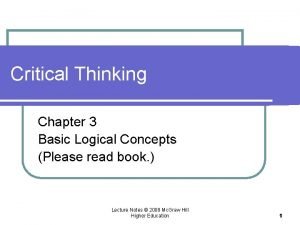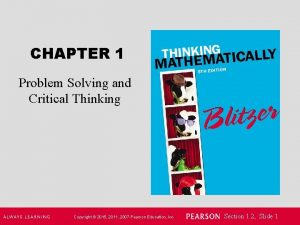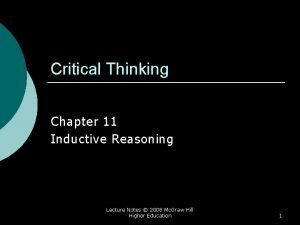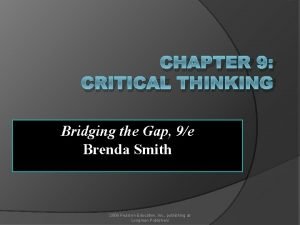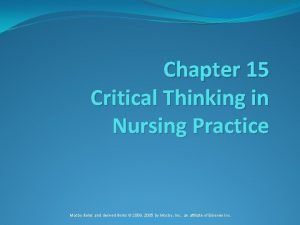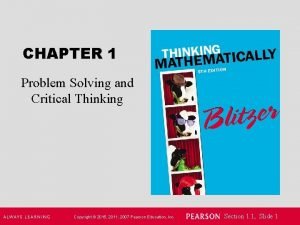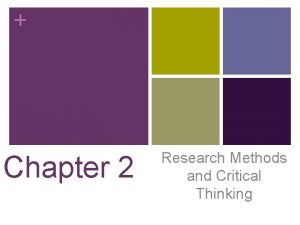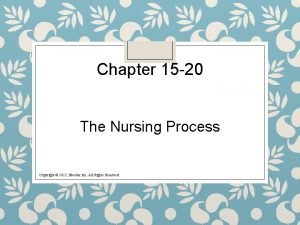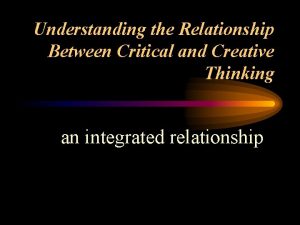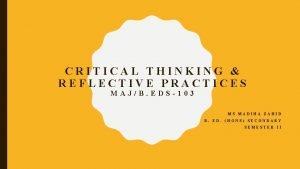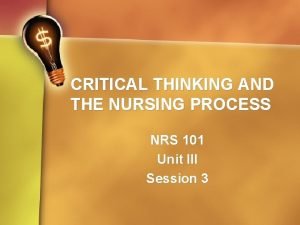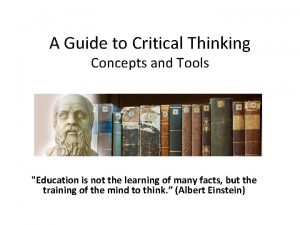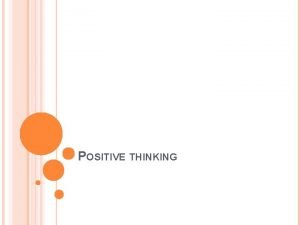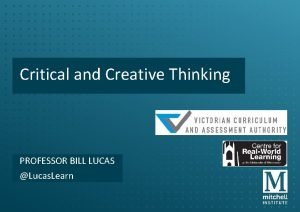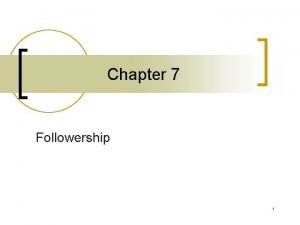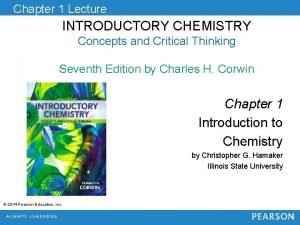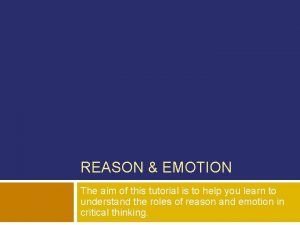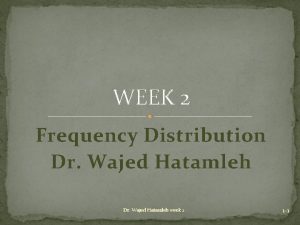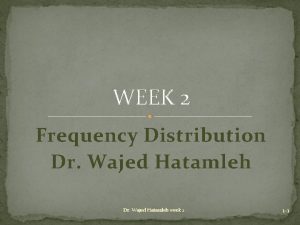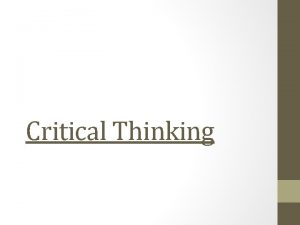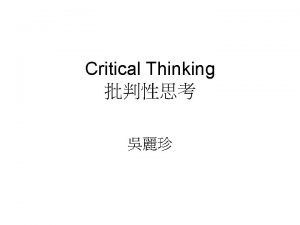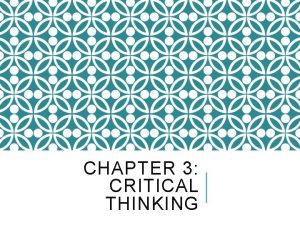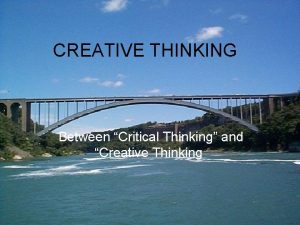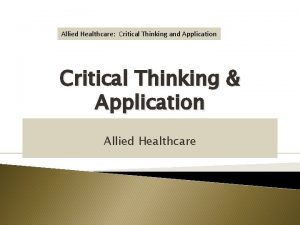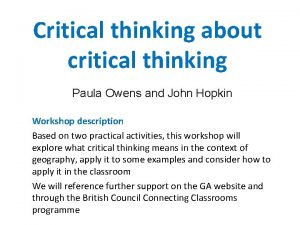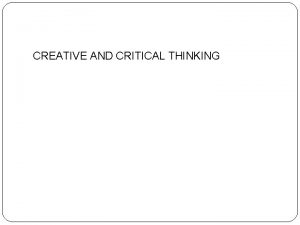Chapter 10 Dr Wajed Hatamleh Critical Thinking and























- Slides: 23

Chapter 10 Dr. Wajed Hatamleh Critical Thinking and Nursing Practice

Learning Outcomes 1. Describe the significance of developing critical-thinking abilities in order to practice safe, effective, and professional nursing care. 2. Explore ways of demonstrating critical thinking in clinical practice. 3. Discuss the skills and attitudes of critical thinking

Learning Outcomes (cont'd) 4. Discuss the relationships among critical thinking, the problem-solving process, and the decision-making process.

BEGIN WITH: Questions: Ø What do I really know about this nursing care situation? Ø How do I know it? Ø What options are available to me?

Critical thinking: • “is the intellectually disciplined process of actively and skillfully conceptualizing, Appling, analyzing, synthesizing and / or evaluation information gathering from or generated by, observation, experience, reflection, reasoning or communication as guide to belief and action”.

Critical Thinking • An intentional higher level reasoning process • Essential component of professional accountability and quality nursing care • Generated from a triad of professional, socioeconomic, and ethical/moral needs

• Creativity is a major component in critical thinking. • • Creativity: is the thinking that results in the development of new idea and products. And is the ability to develop and implement new and better solution

Critical Thinking • Use clinical reasoning and clinical decision making – to practice safe and effective nursing care – to improve clinical systems – to decrease errors in clinical judgment

Critical Thinking Skills • • Analyzing Applying standards Discriminating Information seeking Logical reasoning Predicting Transforming knowledge

Techniques in Critical Thinking Critical analysis Inductive and deductive reasoning Making valid inferences Differentiating facts from opinions Evaluating the credibility of information sources • Clarifying concepts • Recognizing assumptions • • •

Attitudes that Foster Critical Thinking • • Independence Fair-mindedness Insight Intellectual courage

Attitudes that Foster Critical Thinking (cont'd) • Integrity • Confidence • Curiosity

Critical Thinking and Nursing • Critical thinking underlies each step of the nursing process, problem-solving process, and decision-making process

The Nursing Process • Systematic, rational method of planning and providing individualized care – Assessing – Diagnosing – Planning – Implementing – Evaluating

Problem-Solving Process • Clarify the nature of a problem and suggests possible solutions • One situation contributes to the nurse’s body of knowledge for problem solving in similar situations • Commonly used approaches – Trial and Error – Intuition(is the understanding or learning of things without the conscious uses of reasoning (sixth sense). – Research process

Decision-Making Process • Decision making: is the critical thinking process for choosing the best action to met the desired goal • Choosing the best actions to meet a desired goal – Make value decisions (keep client information confidential) – Time management decisions (take clean linens in at the same time as giving medications)

Decision-Making Process (cont'd) • Choosing the best actions to meet a desired goal – Scheduling decisions (bathe clients before visiting hours) – Priority decisions (most urgent and ones that can be delegated)

Steps of Decision making • • • identify the priorities. set the criteria: what need to be achieved. what need to be preserved. what need to be avoided. weight the criteria( set priority). seek alternative. examine alternative. implement (placed into action). evaluate the outcome


Developing Critical Thinking Attitudes and Skills • Self-assessment • Tolerating dissonance and ambiguity • Create environments that support critical thinking

Figure 10 -2 Mind map for critical thinking in nursing. From University of New Mexico College of Nursing. Retrieved from http: //hsc. unm. edu/consg/critical/what_ct. shtml

Box 10 -5 Types of Concept Maps

Figure 10 -3 Types of concept maps: A, hierarchical; B, spider; C, flowchart; D, systems.
 Critical semi critical and non critical instruments
Critical semi critical and non critical instruments Spaulding classification system
Spaulding classification system Perbedaan critical thinking dan creative thinking
Perbedaan critical thinking dan creative thinking Critical thinking chapter 2
Critical thinking chapter 2 Inductive generalization
Inductive generalization Chapter 1 problem solving and critical thinking answers
Chapter 1 problem solving and critical thinking answers Chapter 11 critical thinking
Chapter 11 critical thinking Chapter 9 critical thinking answers
Chapter 9 critical thinking answers Chapter 41 telephone techniques
Chapter 41 telephone techniques Fundamentals of nursing chapter 15 critical thinking
Fundamentals of nursing chapter 15 critical thinking Chapter 1 critical thinking
Chapter 1 critical thinking Critical thinking chapter 2 answers
Critical thinking chapter 2 answers Back channeling nursing
Back channeling nursing Relationship between creative and critical thinking
Relationship between creative and critical thinking Types of nursing diagnoses
Types of nursing diagnoses Critical thinking and reflective practices
Critical thinking and reflective practices Critical thinking attitudes in nursing
Critical thinking attitudes in nursing Critical thinking concepts
Critical thinking concepts Critical thinking positive and negative
Critical thinking positive and negative Critical and creative thinking vic curriculum
Critical and creative thinking vic curriculum Professor bill lucas
Professor bill lucas Independent critical thinking
Independent critical thinking Introductory chemistry concepts and critical thinking
Introductory chemistry concepts and critical thinking Emotions and critical thinking
Emotions and critical thinking




